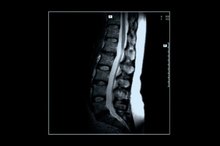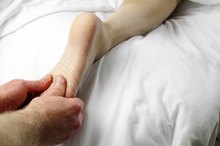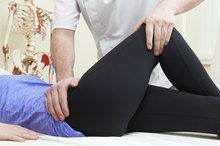L4/L5 Bulging Disc Symptoms
Your spine is made up of a column of bones stacked on top of each other. Discs provide cushioning between each of these bones. Sometimes discs may bulge -- move out of place -- and put pressure on nerves that exit your spine. Symptoms are specific to the level of the bulge. An L4/5 bulging disc puts pressure on your L5 nerve -- one of the most common levels where this condition occurs. Bulging of this disc, located in your lower back, causes a variety of problematic symptoms.
If you are experiencing serious medical symptoms, seek emergency treatment immediately.
Pain
Pain may be the first indicator that you have a bulging disc at L4/5. You may have pain in your lower back, near the top of your pelvis. This pain may increase when you press on the muscle next to your spine where the nerve is compressed, or it might suddenly increase with coughing or sneezing. Daily activities that require bending over or sitting for long periods will typically increase your pain as well. You may have difficulty getting comfortable at night. Pain can radiate down the leg on the same side as your compressed nerve, along the back of your thigh on the outer edge, or along the front, outer part of your lower leg -- the areas supplied by your L5 nerve. You may also have pain in both legs if the disc is pressing on the nerves on both sides of your spine.
- Pain may be the first indicator that you have a bulging disc at L4/5.
- You may also have pain in both legs if the disc is pressing on the nerves on both sides of your spine.
Tingling and Numbness
L5-S1 Pinched Nerve Symptoms
Learn More
Nerves transmit sensations from your skin to the brain, and compression by a disc can interfere with this function or send false signals. A bulging disc at L4/5 may cause tingling or even numbness of the skin that is supplied by your L5 nerve. This occurs most commonly along the top of your foot or the web space between your big toe and second toe. Tingling and numbness may come and go based on the position of your back, or it may be constant. These symptoms typically increase as your bulging disc puts more pressure on your L5 nerve.
- Nerves transmit sensations from your skin to the brain, and compression by a disc can interfere with this function or send false signals.
- A bulging disc at L4/5 may cause tingling or even numbness of the skin that is supplied by your L5 nerve.
Weakness
Your brain sends impulses through nerves to tell your muscles to contract. Compression of your L5 nerve from a bulging disc may cause weakness in the muscles supplied by this nerve. You may notice a decreased ability to lift your foot off the ground -- a condition called foot drop -- or difficulty lifting your big toe. This weakness can increase your risk of falls, as your toe may get caught on the ground as you walk. Surgery may be required to relieve pressure on the nerve if you develop foot drop. Deep tendon reflexes can also indicate nerve compression caused by a bulging disc. When your tendon is tapped with a reflex hammer, it normally causes your muscle to jump. Compression of your L5 nerve can reduce your muscles' response to this stimulus. This reflex is tested at your hamstring tendon on the inside of the back of your knee 3.
- Your brain sends impulses through nerves to tell your muscles to contract.
- Compression of your L5 nerve can reduce your muscles' response to this stimulus.
Warnings
C4 and C5 Nerve Damage Symptoms
Learn More
Some bulging disc symptoms can be an indicator of more serious nerve compression -- cauda equina syndrome 4. This condition causes sudden or progressive loss of bowel or bladder control, impotence, numbness in your perineal area or sudden worsening of leg weakness. Seek immediate medical attention if you experience these symptoms, as they can become irreversible if they're not rapidly treated. Cauda equina syndrome can permanently impair your bowel and bladder function. It can also cause long-term sexual problems or paralysis in your legs.
- Some bulging disc symptoms can be an indicator of more serious nerve compression -- cauda equina syndrome 4.
- Cauda equina syndrome can permanently impair your bowel and bladder function.
Related Articles
References
- Asian Spine Journal: Lumbar Disc Degenerative Disease -- Disc Degeneration Symptoms and Magnetic Resonance Image Findings
- Advances in Clinical Neuroscience and Rehabilitation: The Management of Degenerative Lumbar Spine Disease
- Surgical Neurology International: Diagnostic Performance of the Medial Hamstring Reflex in L5 Radiculopathy
- European Spine Journal: Cauda Equina Syndrome Treated by Surgical Decompression -- The Influence of Timing on Surgical Outcome
- Fardon, D., M.D., et. al. Lumbar disc nomenclature: version 2.0 The Spine Journal. Nov 2014 DOI: https://doi.org/10.1016/j.spinee.2014.04.022
- Fardon DF, Williams AL, Dohring EJ, Murtagh FR, Gabriel rothman SL, Sze GK. Lumbar disc nomenclature: version 2.0: Recommendations of the combined task forces of the North American Spine Society, the American Society of Spine Radiology and the American Society of Neuroradiology. Spine J. 2014;14(11):2525-45. doi:10.1016/j.spinee.2014.04.022
- Baert, AL. Encyclopedia of Diagnostic Imaging, Volume 2. New York, NY: Springer; 2007.
- Hu JK, Morishita Y, Montgomery SR, et al. Kinematic evaluation of association between disc bulge migration, lumbar segmental mobility, and disc degeneration in the lumbar spine using positional magnetic resonance imaging. Global Spine J. 2011;1(1):43-8. doi:10.1055/s-0031-1296056
- The Spine Hospital at the Neurological Institute of New York. Herniated disc (cervical, thoracic, lumbar). Updated 2019.
- Atlanta Brain and Spine Care. A herniated disc or a bulging disc: is there a difference, and how can I tell? Updated 2019.
- American Association of Neurological Surgeons. Herniated disc. Updated 2019.
- Fardon, D., M.D., et. al. Lumbar disc nomenclature: version 2.0 The Spine Journal. Nov 2014 DOI:
- Hu, J., et. al. Kinematic Evaluation of Association between Disc Bulge Migration, Lumbar Segmental Mobility, and Disc Degeneration in the Lumbar Spine Using Positional Magnetic Resonance Imaging. Global Spine J. Dec 2011.
Writer Bio
Aubrey Bailey has been writing health-related articles since 2009. Her articles have appeared in ADVANCE for Physical Therapy & Rehab Medicine. She holds a Bachelor of Science in physical therapy and Bachelor of Arts in psychology from the University at Buffalo, as well as a post-professional Doctor of Physical Therapy from Utica College. Dr. Bailey is also a certified hand therapist.









